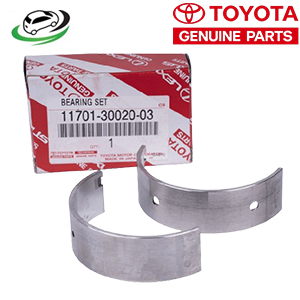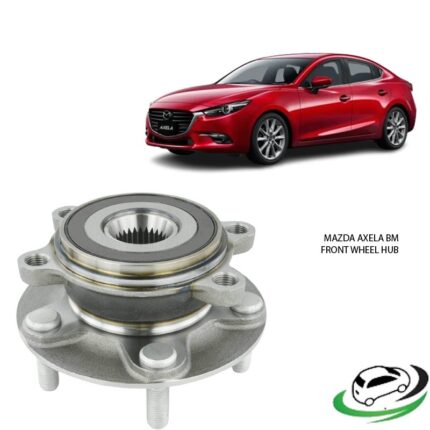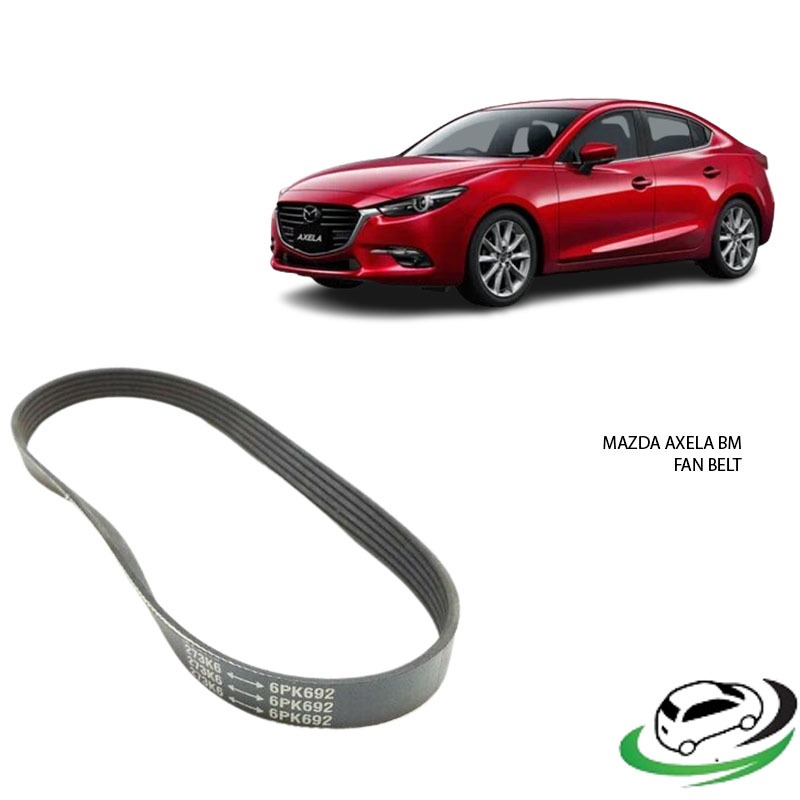-10%
Get Mazda Axela BM V-Ripped Fan Belt 6PK962S
The V-ripped fan belt, often referred to as the serpentine belt or multi-rib belt, plays a crucial role in the operation of modern internal combustion engines. This belt is responsible for driving various engine components, including the alternator, power steering pump, water pump, and air conditioning compressor. Without the V-ripped fan belt, these essential systems would cease to function, leading to engine overheating, battery discharge, loss of steering assistance, and other critical failures.
In this comprehensive guide, we’ll explore the function of V-ripped fan belts, their construction, the importance of proper maintenance, signs of wear, and the process of replacing them.
Function of V-Ripped Fan Belts
The primary role of a V-ripped fan belt is to transfer mechanical power from the crankshaft to auxiliary components in the engine. These components are essential for vehicle operation and comfort, and the belt allows them to run simultaneously through a single belt system.
- Power Distribution:
- The V-ripped fan belt transmits power from the engine’s crankshaft to multiple accessories, including:
- Alternator: Charges the battery and powers the electrical systems when the engine is running.
- Power Steering Pump: Provides hydraulic power to assist steering.
- Water Pump: Circulates coolant throughout the engine to prevent overheating.
- Air Conditioning Compressor: Powers the vehicle’s A/C system for cooling.
- In older vehicles, multiple belts, including V-belts, were used for each accessory, but modern engines use a single V-ripped fan belt for simplicity and efficiency.
- The V-ripped fan belt transmits power from the engine’s crankshaft to multiple accessories, including:
- Serpentine Belt Design:
- The belt is known for its serpentine or winding design, which allows it to drive multiple components in the engine bay with minimal friction and wear.
- Its design is essential for modern engine layouts, where space is limited, and efficiency is a priority.
- Tensioning:
- A belt tensioner, often spring-loaded or hydraulically operated, maintains constant tension on the V-ripped fan belt. This tension is critical for preventing belt slippage and ensuring that all driven components operate smoothly.
- Some older vehicles have manually adjustable tensioners, but most modern vehicles use automatic tensioners to maintain optimal belt tension.
Construction of V-Ripped Fan Belts
The V-ripped fan belt is engineered for durability, flexibility, and strength. It must withstand constant motion, varying temperatures, and exposure to oil and other fluids without degrading or breaking. To meet these demands, the belt is made from several materials designed to maximize its lifespan.
- Rubber Compound:
- The outer layer of the belt is typically made from a high-strength rubber compound that provides flexibility and heat resistance.
- EPDM (Ethylene Propylene Diene Monomer) is the most commonly used rubber material in modern V-ripped belts due to its superior durability and resistance to extreme temperatures.
- Polyester Cords:
- Embedded within the rubber are high-strength polyester or Kevlar cords. These cords provide tensile strength to prevent the belt from stretching under tension.
- The cords also ensure that the belt maintains its shape and alignment, even under heavy loads.
- Multi-Ribbed Design:
- The V-ripped fan belt has multiple ribs on its inner side, which are designed to grip the pulleys and provide superior friction for power transmission.
- The ribs increase surface area contact, which allows the belt to deliver more power to the engine accessories with less slippage.
- The number of ribs on the belt varies depending on the vehicle and engine design, but common configurations range from four to eight ribs.
- Heat Resistance:
- V-ripped belts are designed to resist the high temperatures generated by the engine. The combination of EPDM rubber and polyester cords ensures that the belt remains flexible and durable even in extreme heat.
Importance of Proper Maintenance
Proper maintenance of the V-ripped fan belt is essential to prevent breakdowns and maintain the reliability of the vehicle’s engine systems. A failed belt can lead to various problems, including engine overheating, loss of electrical power, and steering difficulties.
- Preventative Maintenance:
- Regularly inspecting the V-ripped fan belt for wear and replacing it at recommended intervals is crucial for avoiding unexpected failures.
- In most modern vehicles, the V-ripped belt should be inspected every 30,000 miles (50,000 km) and replaced every 60,000 to 100,000 miles (100,000 to 160,000 km), depending on the manufacturer’s guidelines.
- Impact of a Failed Belt:
- A broken or severely worn V-ripped fan belt can cause the engine to overheat if the water pump stops functioning. It can also result in a drained battery if the alternator is not being driven properly, leading to a complete vehicle shutdown.
- The loss of power steering assistance can make the vehicle difficult to control, especially at lower speeds, which can be a safety hazard.
- Extending Belt Life:
- To extend the life of a V-ripped fan belt, regular inspections for cracks, fraying, or wear are essential. Keep an eye on belt tension and ensure that the automatic tensioner is functioning correctly.
- Keeping the belt and its surroundings clean from oil, coolant, or debris also helps prevent premature wear.
Signs of Worn or Damaged V-Ripped Fan Belts
Recognizing the signs of a worn or damaged belt can prevent breakdowns and costly repairs. Common symptoms of a failing V-ripped fan belt include:
- Squealing or Chirping Noises:
- A common sign of belt wear is a high-pitched squealing or chirping noise, especially when starting the engine or during acceleration. This noise is caused by belt slippage, often due to improper tension or worn ribs.
- A squealing belt should be inspected and replaced if necessary, as continued use can lead to belt failure.
- Visible Cracks or Fraying:
- Over time, the rubber in the belt can develop cracks, especially around the ribs. If you notice visible cracks, fraying edges, or glazing (a shiny appearance on the belt’s surface), it’s time for a replacement.
- A cracked belt may continue to function for a short time, but it is at high risk of breaking, which could lead to engine damage.
- Loss of Power Steering or Overheating:
- If the power steering becomes heavy or the engine starts to overheat, the belt may have slipped or broken, preventing the water pump or power steering pump from functioning.
- This is a more advanced sign that the belt has already failed, and immediate action is required.
- Vibration or Belt Misalignment:
- If the belt is misaligned on the pulleys, it may cause vibration or abnormal noise. Misalignment can be due to a faulty tensioner or pulley, and this should be corrected to prevent further damage.
Replacement Process of V-Ripped Fan Belts
Replacing a V-ripped fan belt is a relatively straightforward process but requires proper tools and attention to detail. It’s important to follow the manufacturer’s guidelines to ensure the belt is installed correctly and tensioned properly.
- Tools Required:
- Basic tools, such as a socket wrench, a belt tensioner tool, and a belt routing diagram (usually found under the hood or in the owner’s manual), are needed for the replacement.
- Step-by-Step Process:
- Step 1: Locate the Belt: The V-ripped belt is typically located on the front of the engine. Use the belt routing diagram to understand how the belt is routed over the various pulleys.
- Step 2: Relieve Tension: Use the belt tensioner tool to relieve the tension on the belt by rotating the tensioner in the direction specified in the manual.
- Step 3: Remove the Belt: Once the tension is released, carefully slide the old belt off the pulleys. Take note of the belt’s routing for proper reinstallation.
- Step 4: Inspect the Pulleys: Check the pulleys for any signs of wear or damage, such as rough surfaces or excessive play. Replace any worn pulleys before installing the new belt.
- Step 5: Install the New Belt: Route the new belt according to the diagram, ensuring that it sits correctly in the grooves of each pulley.
- Step 6: Reapply Tension: Release the tensioner tool slowly to allow the tensioner to apply pressure to the new belt.
- Step 7: Test the Installation: Start the engine and observe the belt’s operation. Ensure there are no abnormal noises and that the belt is properly aligned on the pulleys.
Conclusion
The V-ripped fan belt is a vital component in modern engines, ensuring that key systems such as the alternator, power steering, water pump, and air conditioning work properly. Its multi-ribbed design offers superior friction, power distribution, and durability compared to older belt designs. Regular maintenance, inspection, and timely replacement are crucial to ensuring the belt performs reliably, preventing breakdowns and costly repairs. By understanding its function and taking proper care, you can keep your vehicle running smoothly and avoid unexpected failures.
Follow us on Facebook for more parts.






Reviews
Clear filtersThere are no reviews yet.